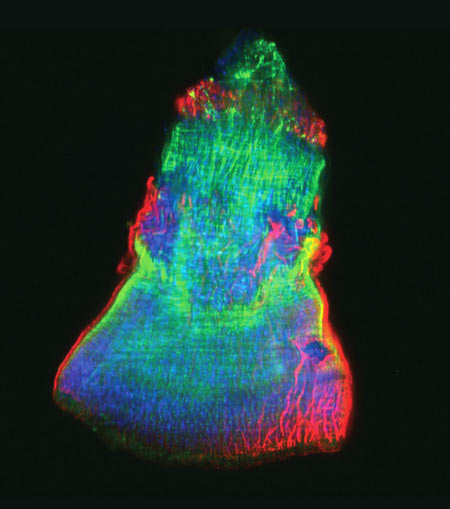
This rainbow-hued image shows the isolated feeding tube, or pharynx, of a tiny freshwater flatworm called a planarian, with the hairlike cilia in red and muscle fibers in green. Scientists use these wondrous worms, which have an almost infinite capacity to regrow all organs, as a simple model system for studying regeneration. A research team led by Alejandro Sánchez Alvarado of the Stowers Institute for Medical Research exploited a method known as selective chemical amputation to remove the pharynx easily and reliably. This allowed the team to conduct a large-scale genetic analysis of how stem cells in a planaria fragment realize what’s missing and then restore it. The researchers initially identified about 350 genes that were activated as a result of amputation. They then suppressed those genes one by one and observed the worms until they pinpointed one gene in particular—a master regulator called FoxA—whose absence completely blocked pharynx regeneration. Scientists believe that researching regeneration in flatworms first is a good way to gain knowledge that could one day be applied to promoting regeneration in mammals.
Learn more:
Stowers Institute News Release
Sánchez Lab


Exciting research!
what are the benefit for human especially for those get a disease and some part of an organ has to be removed ?
“what are the benefit for human especially for those get a disease and some part of an organ has to be removed ?”
The nature of the research highlighted above is very basic, and the potential medical applications are still a long way off. But there is a long record of how fundamental knowledge gained through basic research ultimately leads to advances in disease diagnosis, treatment or prevention. For more about how studies of so-called model organisms can improve understanding of human biology, read the Using Model Organisms to Study Health and Disease fact sheet and How Animals Offer Clues to Regeneration article.
350 genes are activated for regeneration after amputation in an organism–very interesting to know